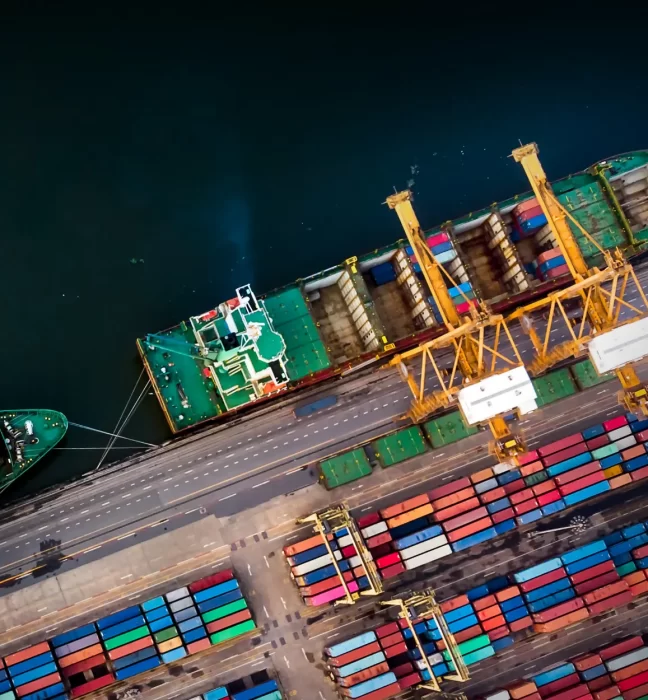Although capital markets are changing, interest rates are increasing, and construction pricing is at record highs, the Southeast is experiencing rapid industrial growth as the need for industrial space in the US continues to rise. Driven by a growing population and a surge in e-commerce and manufacturing, the Southeast’s ports and business-friendly policies are part of why industrial demand is outpacing supply.
Perfectly Situated.
With digital revenue up 54% since 2019, companies are searching for ways to store and ship products more efficiently. The Southeast provides extraordinary access to the US population through I-85 within a 24-hour timeframe, a win when considering DOT regulations. But that isn’t the only draw.
“Gaps often overlooked within our supply chain have come to a head over the past two years, requiring companies to consider different options when transporting and storing product,” said Jason Schnittger, Managing Director of Stream’s Charlotte office. “Port-related activity, automotive and EV-related users, and other manufacturing users have been like gasoline on already white-hot demand across the Southeast region.”
Exponential port growth has caused the Port of Savannah’s TEU totals to nearly double over the past decade and Inland Port Greer to increase 14% in 2021. As such, ports throughout the Southeast are investing billions to strengthen their infrastructure.
According to Brad Bays, SIOR, Managing Director and Leader of Stream’s Industrial Division in Atlanta, the influx of port activity has created a significant demand for industrial space. “We keep developing bigger-box properties, and most are leasing up prior to delivery,” said Bays. “Because of this, we are seeing substantial rent increases, with rates two to three times higher than they were just two years ago.”
Mounting port activity has also increased demand for Industrial Outdoor Storage (IOS), giving rise to a newer, $200-billion asset class that provides additional storage for bulk materials, trailers, and drops.
Unmatched Incentives.
To meet industrial demand, YardiMatrix predicts that more than 350 million square feet of new space is needed annually, totaling 1.8 billion by 2026. To capitalize on this trend, the Southeast has numerous economic incentives in place, such as port volume increase credits and low tax rates, adding to the region’s overall appeal. Federal legislation is playing a role as well.
The Creating Helpful Incentives to Produce Semiconductors (CHIPS) Act of 2022 provides $52.7 million for American semiconductor research and development, and workforce development, along with a 25% tax break for domestic manufacturing. With such incentives, Hyundai announced its plans to open a $6.5 billion EV and battery manufacturing facility near Savannah, GA, and Toyota recently purchased 2,000 acres in Greensboro, NC, for a $1.3 billion battery plant.
BMW and Volvo are also active in South Carolina, with BMW announcing a major expansion to their GSP manufacturing plant and Volvo announcing two new GSP plants.
“The Southeast is quickly becoming a second Detroit, in the sense that auto manufacturers and key suppliers are flocking to the region,” said Bays. “We’re becoming the automotive capital of the US.”
Growth is not without its challenges.
While other regions may boast wide open available land suitable for industrial development, Atlanta and the Carolinas face specific topographical challenges not seen elsewhere, resulting in some limitations.
“Unlike other regions, here in the Carolinas, natural water features can hinder development,” said Schnittger. “Also, because growth has happened so rapidly, some municipalities have had difficulty keeping up with infrastructure, making available and developable land harder to come by.”
In prior cycles, rising construction and land costs resulted in higher rents which stunted demand for space. But this cycle is very unique. Even with rising construction prices, land prices, and rent, demand has continued un-checked—though increased debt costs and continued high construction costs could potentially slow down speculative development.
“Tenants need space to meet consumer demands and future changes. So, despite ever-increasing rental rates over the last several quarters, demand hasn’t wavered,” said Bays. “However, as rental rates increase, some companies have found that 3PLs provide greater flexibility, especially if they’re uncertain about signing a long-term deal in today’s economic environment.”
Currently, 3PL accounts for 39% of Atlanta’s total demand for space over 100,000 square feet.
Positioned for Success.
As the market continues to evolve, there are many questions and opportunities that Schnittger and Bays are prepared to tackle. “Our goal is to provide clients with the latest information and trends to make an informed decision,” says Schnittger. “Stream’s agile, innovative platform provides us the resources to do just that.”
Bays couldn’t agree more. “The demand is high, as is development. More than 18 million square feet of industrial space are under construction in Savannah alone. Between the population increase, location, and economic incentives, it’s not really a surprise. The Southeast has much to offer.”
Jason Schnittger is a Managing Director in Stream’s Charlotte office, leading industrial growth across the Carolinas. He previously served as Managing Director of Stream’s San Antonio office and has more than 20 years of commercial real estate experience.
Brad Bays, SIOR, is the Managing Director and Leader of Stream’s Industrial Division in Atlanta. With nearly 20 years of experience, Brad has completed more than 10 million square feet of industrial, flex, land, and construction transactions, accounting for $200 million in transactions.
